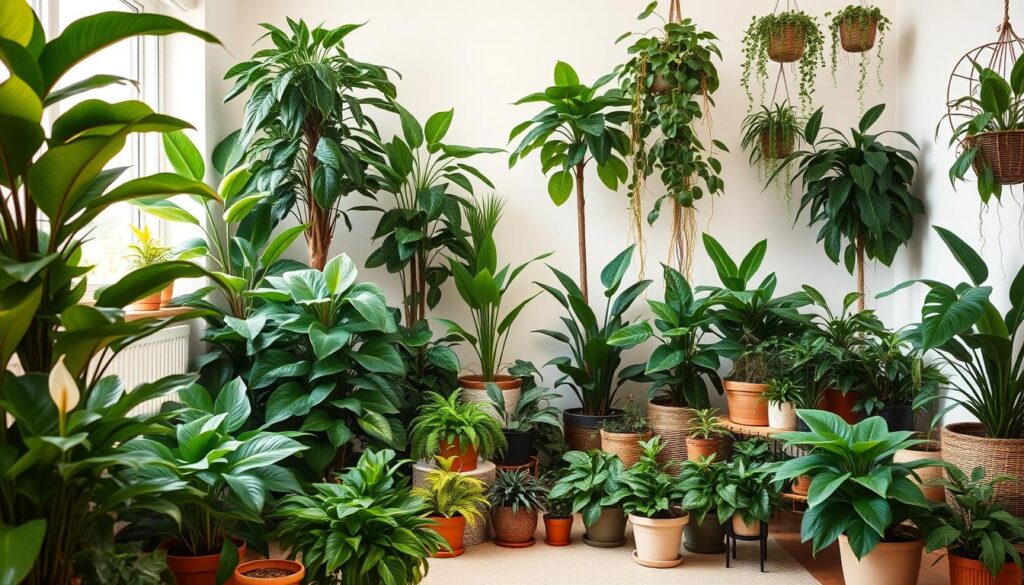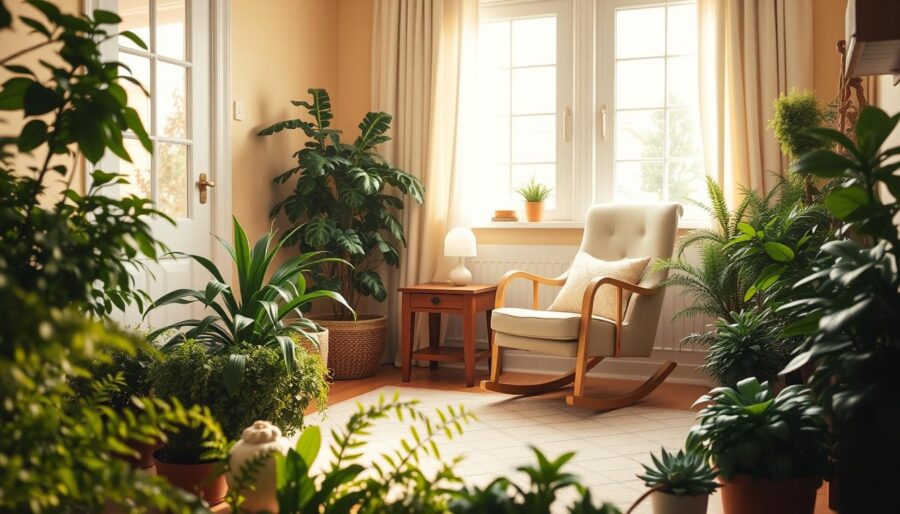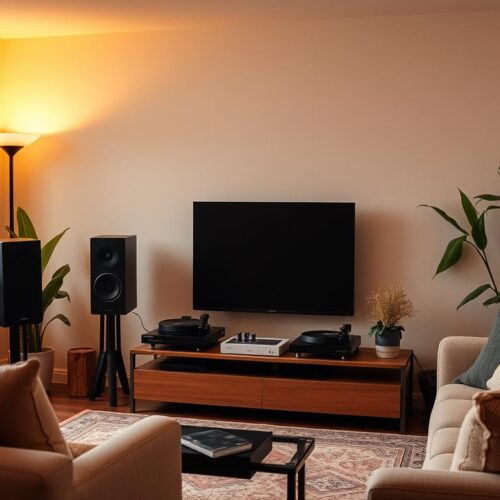As a new parent, you may find yourself loving every quiet moment in your baby’s room. The gentle movement of leaves and the calming greenery might do more than look pretty. In our homes’ silent spots, surrounded by plants, there’s a hidden wonder – how plants affect sound.
More and more, experienced parents and experts are noticing this special connection. Plants have special features that aren’t just about looks, including making sounds softer. By adding plants to your baby’s room, you could be making a peaceful space. Here, everyday noise seems quieter.
Let’s see how these beautiful parts of nature can change the sound in your baby’s special room. They offer beauty and a peaceful spot.
Understanding Acoustics and Their Importance in Baby Rooms
Acoustics are vital for a calm and cozy baby room. In rooms full of hard surfaces, noises can echo, making things tense for infants. Adding items that suck up sound helps lower noise. This introduces eco-friendly soundproofing, which uses green materials to manage sound.
It’s important to keep noise down for your baby’s health and peace. Babies don’t like loud or sudden noises; it can mess with their sleep and make them unhappy. Things like plants can catch, soak up, and bend sounds. This makes the room quieter and nicer, which is great for your baby’s growth.
How Plants Affect Room Acoustics
Plants make nursery rooms sound better through natural sound control. They deflect sound using leaves and branches. This lowers noise and makes the room peaceful.
They also absorb sound with their stems and trunks. This natural soundproofing cuts down on unwanted noise. It makes the room quieter and nicer for babies.
Refraction is another key method. Sound waves change direction as they pass through plants. This reduces echoes and improves sound quality. Thanks to this, nursery rooms stay calm and good for sleeping.
Using plants for sound control improves the room’s sound and is eco-friendly. This makes adding greenery to nursery decor smart and good for the planet.
Types of Plants That Improve Acoustics
Choosing the right plants for a nursery can greatly improve the sound quality. Ferns are amazing because they can soak up to 98% of sound. This makes them great for keeping unwanted noise away. Their thick leaves and dense foliage help block sound.

Snake plants are another good option for better room sound. They don’t need much care and can grow in different lights. Their tall shape helps break up sound waves in the room.
Monsteras add a splash of tropical style and are great for sound too. Their big, holey leaves cut down on echo. The way they’re built helps make a nursery’s sound nicer.
Add these plants to your baby’s nursery for a calm and quiet space. Choosing ferns, snake plants, and monsteras improves the room in looks and sound. They bring peace and beauty together.
Here’s a quick guide to help you pick the best plants for sound in your nursery:
| Plant | Sound Absorption | Care Requirements |
|---|---|---|
| Ferns | Up to 98% | Moderate, prefers humidity |
| Snake Plants | Moderate | Low, tolerates low light |
| Monsteras | High | Moderate, needs space to grow |
In conclusion, these nursery plants will make your baby’s room more peaceful. They help create a serene and lovely space.
Additional Benefits of Plants in Baby Rooms
Adding plants to baby rooms does more than beautify the space. They improve air quality by making oxygen and taking in carbon dioxide. This makes the room healthier and nicer for your baby.
Plants also make the room calming, which is great for babies and parents alike. The greenery lowers stress and makes everyone feel happy. So, plants help keep the environment and our minds healthy.
Plants are not just for clean air; they also decorate the room. Their green color and natural look match many nursery themes. Plus, they clean the air by removing toxins, keeping the room fresh.
The idea of biophilia tells us we are drawn to nature. Having plants in a baby’s room strengthens this bond from an early age. So, babies can learn to love nature for life. Plants in nurseries do more than quiet sounds—they help babies grow in a loving, healthy space.
Plant Placement for Optimal Acoustic Benefits
To make a baby’s room quieter with sound absorption, it’s smart to place plants around the edges. Putting plants around the room catches and blocks noise. This tactic creates a natural way to reduce sound that also looks great.
Using plants as natural dividers is another great strategy. Tall, leafy plants by the corners or walls help break up sound and cut down echo. Mixing different types and sizes of plants can make the sound in a room better balanced.
Here are some easy ways to arrange plants for the best sound absorption:
- Big plants in corners can catch deep sounds well.
- Medium plants along walls help stop sounds bouncing around.
- Small plants on shelves or sills spread out the quietness.
- Hanging plants can catch noises from above, adding more eco-friendly soundproofing.
Incorporating Plants into Decor
Adding plants to your baby’s room is not only lovely but useful too. They help control noise indoors with their presence. You can hang plants to soften sounds in spaces with tall ceilings. This also adds a beautiful focal point.
Choosing matching pots can boost the nursery’s style. Pick pots that suit the nursery’s theme, be it modern, rustic, or themed. By using pots that match your style and mixing different plant colors, you make the room look great.
Here are some simple ways to bring plants into your baby’s room:
- Install hanging pots with trailing plants like Pothos or Spider Plants to create soft, cascading greens.
- Position larger potted plants, like Rubber Plants or Fiddle Leaf Figs, near corners to effectively diffuse sound.
- Use plant stands or wall-mounted shelves to elevate smaller plants, making sure they are out of reach of curious little hands.

| Plant Type | Recommended Placement | Benefits |
|---|---|---|
| Spider Plant | Hanging pots or shelves | Improves indoor air quality, excellent for noise control |
| Fiddle Leaf Fig | Room corners | Enhances decor, effective in reducing noise |
| Pothos | High shelves or hanging pots | Easy maintenance, great for noise absorption |
| Rubber Plant | Corner placement | Excellent sound absorber, low maintenance |
Maintenance Tips for Acoustic Plants
Maintaining indoor greenery for noise control is simple with the proper care. Essential tips can help keep your acoustic plants healthy. They’ll be more effective at soaking up sound this way.
Watering Regime: A regular watering schedule is vital. Keeping the soil slightly moist is best for most plants. Too much water can cause root rot. Too little and they’ll wilt and lose noise control efficiency.
Light Requirements: Plants need the right light for photosynthesis. Make sure they get enough indirect sunlight. Direct sun can damage the leaves. Choose low-light plants for darker areas.
General Care Tips: Dust the leaves often for better sound absorption. Remove dead or yellow leaves to keep the plant looking good. Give them fertilizer every month during their growing season for strong growth.
Keep the temperature and humidity consistent for your plants. Big changes can stress them out, hurting their noise control work.
Following these care tips will keep your plants healthy. They’ll continue to be great for acoustic benefits without too much trouble.
Acoustic Panels vs. Plants: A Comparison
When thinking about ways to soak up sound in baby rooms, acoustic panels and plant-based soundproofing stand out. Each has special perks that meet different tastes and needs.
| Aspect | Acoustic Panels | Plants |
|---|---|---|
| Primary Function | Designed specifically for sound control. | Offers natural sound absorption through leaves and branches. |
| Aesthetic Appeal | Available in various designs, but may not blend naturally into room decor. | Adds a touch of greenery and aesthetic enhancement to the space. |
| Additional Benefits | High performance in sound absorption, tailored for various acoustic needs. | Besides sound absorption, provides air purification and promotes a calming environment. |
| Eco-Friendliness | Materials vary; some may not be eco-friendly. | Completely eco-friendly soundproofing option that benefits the environment. |
| Maintenance | Low maintenance; periodic cleaning might be required. | Requires regular watering and care. |
Real-Life Examples of Plants Enhancing Acoustics
Parents and nursery experts see the benefit of plants in nurseries. For instance, Nicole Roberts from Austin, Texas, found peace lilies helpful. “They quieted my baby’s room, improving his sleep,” she says.
Daycare centers notice these benefits too. The Little Learners Daycare in New York saw a drop in noise after adding indoor plants. This made their space quieter and better for napping and play.
The Children’s Hospital of Philadelphia saw a 30% noise decrease with ferns and rubber plants. This change made the hospital calmer for kids and helped caregivers feel more at ease.
Such stories highlight how plants can naturally improve a room’s sound quality. They prove useful for anyone looking to create a more peaceful environment. Follow these examples if you want to better your baby’s room acoustics.
DIY Acoustic Solutions with Plants
Adding DIY plant projects to your baby room makes it sound better and more calming. Plants are not just pretty. They also help block unwanted noise in a natural way. By placing plants carefully around the room, you create a welcoming space that sounds great for your baby.
- Hanging Planters: Use stylish hanging planters to add plants at different levels. This helps with sound and makes use of wall space.
- Vertical Gardens: Build a vertical garden with a strong frame and pots. It acts like a living sound barrier that also looks good.
- Corner Greenery: Put big plants, like fiddle leaf figs, in room corners. They’re great at soaking up sound and decorating empty spots.
- Plant Shelves: Set up shelves on your walls and fill them with small potted plants. This not only beautifies the room but also improves sound quality.
One big plus of these DIY plant projects is their natural soundproofing power. Plants soak up sound better than artificial stuff, offering a peaceful sound setting for your baby. They also make the room look and feel tranquil and nurturing.
Trying these simple ideas can really change how your baby’s room sounds. Plus, you’ll enjoy the many benefits plants offer.
Conclusion: The Role of Plants in Creating a Calming Environment
Plants greatly improve a room’s acoustics, especially in baby rooms. By adding certain types of plants, you can make the sound quality better. This shows how closely plants and sound go together. Plants like the Fiddle Leaf Fig and Snake Plant are great for absorbing sound. They also make the room look and feel nicer.
Plants do more than just make a room quieter. They clean the air, lessen stress, and bring calm. By placing and caring for these plants well, their benefits are fully enjoyed. This makes both the look and sound of the room better.
In summary, plants are a great way to make your baby’s room calm. The right plants can change the room into a peaceful place. This helps your baby sleep well and stay happy. Let plants bring a peaceful and beautiful feeling to your nursery.




